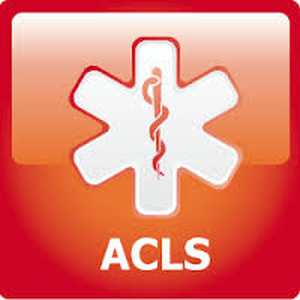

MedFriendly®


Advanced Cardiac Life Support (ACLS)
ACLS is an abbreviation for Advanced Cardiac (or
Cardviovascular) Life Support. ACLS is a group of
interventions used to treat life threatening emergencies
such as stroke and stoppage of blood flow due to
ineffective heart contractions. A stroke is decreased
blood flow to the brain due to a burst artery (a type of
blood vessel that carries blood away from the heart) or
a blockage of an artery in the brain. Online ACLS
courses are offered to teach these interventions and
those passing the course receive certification that they
have the knowledge and skill to use such interventions.
The ACLS guidelines were last updated in 2010 by the American Heart Association
(AHA) and the International Liaison Committee on Resuscitation (ILCR).
FEATURED BOOK: ACLS Study Guide
WHO ARE ACLS GUIDELINES GEARED TO?
The types of health professionals that use ACLS are physicians, pharmacists, dentists,
nurses, nurse practitioners, physician assistants, and emergency responders (e.g.,
paramedics). These are health care professionals who may be in positions where they
are directing or participating in the assessment and treatment of circulatory emergencies
and emergencies involving the heart and/or vascular system. These health care
providers are typically located in emergency departments or intensive care units. For
emergency treatment of children, see the entry on Pediatric Advanced Life Support.
"Where Medical Information is Easy to Understand"™
WHAT ARE THE MAIN NEW CHANGES IN THE 2010
GUIDELINES?
The new guidelines focus on training in basic life support (BLS) as
being central to ACLS. There is increased emphasis on using end
tidal carbon dioxide monitoring as a measure of the return of
spontaneous circulation (ROSC; when perfusing heart activity
resumes) and to optimize the quality of cardiopulmonary
resuscitation (CPR ) effectiveness. End tidal carbon dioxide
monitoring is a non-invasive measure of exhaled carbon dioxide that
calculates the concentration of exhaled carbon dioxide at the end
of a breath.

It is measured with a non-invasive technique known as quantitative waveform capnography, which is
now the recommended way to confirm and monitor placement of an endotracheal tube (a tube placed in
the trachea to temporarily assist with breathing by keeping the airway open).
CPR is an emergency manual procedure (e.g., chest compressions, mouth to mouth breathing) to
preserve partial flow of oxygen to the brain until other measures are used to restore blood circulation
and breathing due to ineffective heart contractions. In the 2010 guidelines, the CPR steps were
rearranged from an ABC acronym to a CAB acronym (except for newborns), where A stands for airway
(opening it and ensuring it is clear), B stands for breathing (looking, listening, and feeling for breathing)
and C stands for chest compressions.
In addition to the importance of CPR in saving lives after cardiac arrest, defibrillation also performs an
important role. Defibrillation is the application of a high electrical shock to the heart to establish a normal
rhythm. Defibrillation is more commonly used these days because automated external defibrillators are
more widely available. They are called external because the pads that detect the heart rhythm and
deliver the shock are placed externally on the body. They are automated because the heart rhythm
detection and shock delivery can be done by the device. This is what happens in the basic life support
use of the device but in ACLS, the team leader makes such decisions based on the patientís heart
rhythms and vital signs.
Another change in the 2010 ACLS guidelines is that atropine is no longer recommended for routine
treatment of pulseless electrical activity (PEA) or asystole. Atropine is a naturally occurring substance
(from the Belladonna plant) that is used to increase the heart rate. PEA is a situation that occurs during
circulatory arrest when a heart rhythm is observed on an electrocardiogram (a test that measures the
electrical activity of the heart) that should be producing a pulse but is not. Asystole is when no electrical
activity is noted in the heart and is commonly referred to as flatlining. Rather than using atropine,
epinephrine (adrenaline) and amiodarone are often administered depending on the situation. Epinephrine
is a medication that increases cardiac output. Amiodarone is a medication that helps treat abnormal
heart rhythms. In the 2010 guidelines, adenosine is recommended as a safe and potentially effective
therapy in the initial management of a type of rapid heart rhythm known as stable undifferentiated regular
monomorphic wide-complex tachycardia. For symptomatic and unstable bradycardia (types of
abnormally low heart rhythm) infusions of chronotropic drugs (drugs which change the heart rate) are
recommended as an alternative to trancutaneous pacing. Transcutneous pacing is the delivery of pulses
of electric current through the patient's chest, which stimulates the heart to contract.
WHAT IS THE DIFFERENCE BETWEEN BLS AND ACLS?
Although basic life support (e.g., CPR) can be taught to lay people, ACLS is much more advanced and
requires extensive training, practice, and hands-on training. It can only be performed by qualified health
care providers because it involves airway management (e.g., placement of tubes to assist breathing),
beginning intravenous access (e.g., to hydrate the patient or administer medication), quickly searching
for possible causes of circulatory arrest, reading and interpreting electrocardiograms, and understanding
how to administer emergency medications and other treatments based on the specifics of the situation.
The latter involves learning and memorizing numerous ACLS algorithms, which are instructional sets
(usually in yes/no flowchart format) designed to standardize treatment and increase its effectiveness.
These algorithms are simplified in the 2010 version and emphasize the use of high-quality CPR. This
includes compressing the chest at an adequate rate and depth, allowing the chest to recoil after each
compression, reducing interrupted chest compressions, and avoiding excessive ventilation.
WHAT IS THE HISTORY OF THE ACLS GUIDELINES?
The ACLS guidelines were first published in 1974 by the AHA and were updated in 1980, 1986, 1992,
2000, 2005, and 2010.














